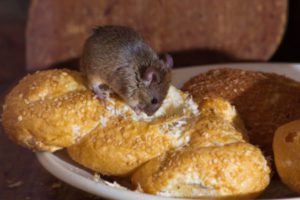EXTRA STORED FOOD CAN MEAN EXTRA MICE!
By Zachary Ciras on February 1, 2021.
Lately, we’ve had more food in our house than usual since we shop a bit extra when we get a chance. Fortunately, we have a pantry to store most of it but my wife found what appear to be mouse pellets in a corner on the floor and on a couple of shelves. She’s freaked out by the idea of mice infesting our food (okay, I am too!) I placed a couple of traps but no luck. What do you advise? So far, we haven’t found their nest.
J. P., Hooksett, NH
You don’t say that you’ve seen actual mice, but we’ll assume that the fecal “droppings” you are seeing came from mice. There aren’t too many things that look similar — a few that come to mind are pupal cases of some small flies or food beetles or moths (also caraway seeds and some other dark seeds). But, if you are seeing black, spindle-shaped (elongate and tapered at each end), ¼-inch long pellets that are deposited in small groupings, they probably are mouse droppings.
Looking at the number of droppings, you may think you have dozens of mice. Hopefully that’s not the case. A single mouse can deposit as many as 70 fecal pellets a day, in small piles, as it moves around. Fresh pellets are soft and shiny black. Older pellets are more gray in color and brittle (see All About Mouse Poop!). Removing old droppings will help you determine if mice are still active.
An inspection by a Colonial pest management professional could tell you for sure if mice are present. You can save some pellets to help the inspector with identification.
SEARCHING FOR A MOUSE NEST
A mouse nest is not necessarily a fluffy round ball. It is more often an irregular, loose softball-sized mass of all kinds of bits of soft materials (shredded paper or fabric, tissues, dryer lint, yarn or string, insulation, leaves, etc.). See Where Do Mice Nest?
The mouse’s nest may, or may not, be in the pantry itself. Mice like to nest in dark, undisturbed areas near ground level and usually only 20-30 feet from a food source. However, that can be 20 feet in any direction so the nest could be in a wall void, a room next door, or above or below the pantry.
Next thing you need to do is check your pantry for openings that could let mice in from other areas. Look for a gap under the pantry door (it doesn’t have to be much of a gap), openings where utility lines or pipes enter wall voids (mice use these lines as highways to travel inside walls), and openings into ceiling light fixtures and the ceiling void. Caulk or otherwise seal these openings.
Another clue is that mice often hoard food in hidden areas for later use. So you may find a pile of moldy dog food pellets or seeds in a wall void or in the back of an unused cabinet drawer (see How Did Dog Food Get Into A Wall Void? Think Mice).
PROPER FOOD STORAGE TO DETER MICE

Mouse in the kitchen eating bread
You, or your wife, no doubt have discovered what the mice were feeding on in the pantry and have removed it. Check all other food items, especially those on the backs of shelves or in less disturbed corners. Foods that are in mouse-chewable packaging such as boxes or bags are most susceptible.
You can make your pantry less mouse-friendly by uncluttering, allowing space between items on shelves, and keeping any bulk foods up off of the floor (mice can climb shelves but it makes access a little more difficult).
Store vulnerable food items in mouse-proof containers with tight-fitting lids. Mice can chew through even plastic containers, so glass and metal canisters are the best bet. Diligently clean up any food spills.
TO TRAP OR NOT TO TRAP?
When trapping mice, try a snap trap with an expanded trigger plate for better results. Assuming the mice have food available in the pantry, tying desirable nest material (cotton ball, yarn, etc.) onto the traps instead sometimes works better.
Place traps in out-of-the-way places in back corners and where you have seen droppings (see How to Place Snap Traps for Mice). If you have small children or pets, place snap traps inside tamper-resistant rodent stations. Be sure to check the traps daily to replace bait and remove dead mice; you don’t want that smell in your pantry.
Since I’m guessing that your pantry might be adjacent to your kitchen, much of this same advice applies also to the kitchen. Look there for nests and droppings, and be sure food (including pet food) and garbage is not available to tempt mice. It won’t do you much good to mouse-proof and fortify your pantry if your kitchen is feeding and housing mice as well. See You Can Help With Your Own Mouse Problem.
Many people don’t want the task of killing mice at all – a good reason to call Colonial Pest Control. Let us do the dirty work.
Our technicians use low contact, COVID-19 precautions. Colonial Pest Control’s COVID-19 Response statement outlines our commitment to you in keeping everyone safe while keeping your home pest-free.